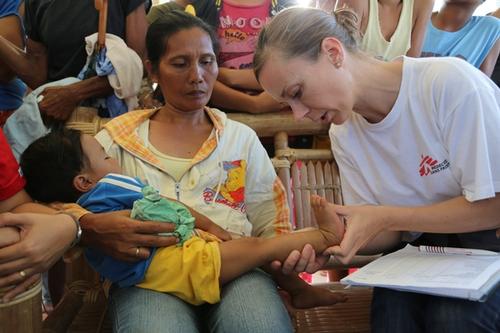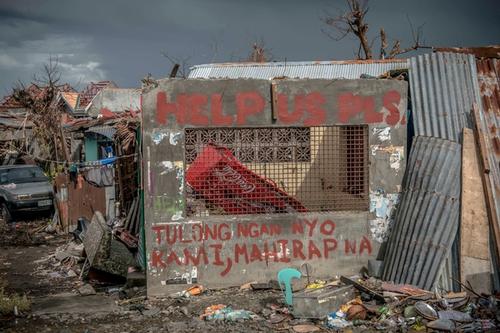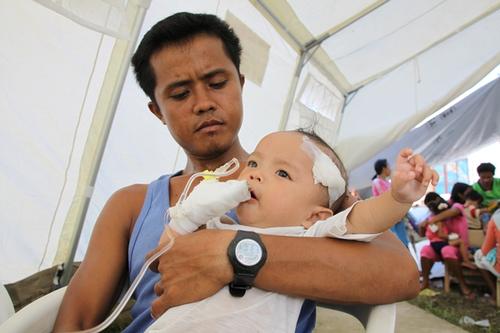After four days of clinic consultations, MSF’s Dr Natasha Reyes describes the physical and mental injuries prompting people to seek medical care.
“MSF has been carrying out medical consultations in the ruined town of Guiuan for the past four days. Six hundred patients came on the first day, and although numbers dropped on subsequent days, it gives an indication of people’s health needs in the typhoon affected zone. At the same time, MSF teams on different islands are doing their first consultations, so we are beginning to build up a picture of the needs and the individual human suffering that has accompanied this disaster.

Injuries caused by fierce wind
The most serious cases we’ve seen in Guiuan are people with injuries directly caused by the impact of the fierce wind. We’ve seen around 60 people needing minor surgery – procedures needing local anesthetic for suturing, cleaning of infected wounds and the routine setting of broken bones. The team saw some very nasty head wounds. Some had previously been stitched up but had since become infected, and the clinic had to start again and clean the wound.
We also saw a number of people with diabetes who have badly infected wounds. They just don’t heal so well, and there is at least one man who will probably have to have an amputation because the infection has become dangerously advanced.
Wounds from walking through wreckage
MSF’s team in Santa Fe town, not far from Tacloban on Leyte island, have seen around 150 people at their clinic, and report the same kind of injuries. There are cuts and wounds from nails, from stepping on the wreckage of buildings. So tetanus vaccination is a top priority.
Indirect victims with chronic diseases
Then there are the large number of people who were the indirect victims of the storm, like an older man I saw with chronic obstructive pulmonary disorder, a serious lung condition. He wasn’t doing well. He had lost his inhaler, which is distressing and dangerous in his condition. For people with chronic diseases like that, it’s particularly hard. We have also seen children who are epileptic and have run out of their medication.
Illnesses from dirty water
There are also children with gastro-intestinal infections and diarrhoea, almost certainly from drinking dirty water, which is all that’s been available. The exposed, wet conditions have aggravated respiratory tract infections, which are common too. But the teams say that these illnesses are not yet at alarming levels.
Alert to deadly disease outbreaks
MSF’s teams on Panay island, to the west, have seen more than 350 patients in their three clinics in and around Estancia, and the pattern is much the same there. All of our medical teams are on the lookout for the very dangerous diseases that are endemic in the area – typhoid, schistosomiasis, cholera and leptospirosis. We haven’t yet seen any cases, but the worry is that the conditions people are living in as a result of the disaster might trigger an outbreak.
First baby born in MSF clinic
One of our priorities will be to provide maternal and obstetric services. In Guiuan, the MSF team helped deliver their first baby on Monday. Before the typhoon, the town’s hospital saw 10 or 15 births a day. There are always women with complications that might need surgery, so the capacity for obstetric services clearly needs to be increased.
Mysterious pains point to psychological cause
Mental health – and the inevitable psychological impact of the disaster on people living through it – is also a focus for our teams. On Panay island, people are coming to the clinic with physical symptoms that may well have an underlying psychological cause: they describe mysterious pains in the body, as well as nightmares and disturbed sleep. These symptoms are a normal response – but often they don’t know that. We need to get out there and tell everyone that this is an absolutely natural reaction. In Guiuan, we started providing mental health consultations for patients and the Filipino medical staff on Monday and on Tuesday we began mental health services out in the community.
Many people are too busy now to absorb what has happened. I met a woman who had lost her daughter and her mother in the typhoon. She told me about it in a very matter-of-fact way, and said that she cried when it happened but had not cried since. I think many of the effects of the disaster will be delayed. Our teams will be busy for some time.”





